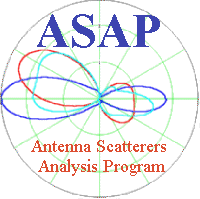

A Helix makes an excellent test case for a thin wire analysis program as the wire segments end up being skew to each other. There has also been an extensive examination of helix antennas using NEC that can be used for comparison. The NEC examination was performed by Darrel Emerson, "The Gain of an Axial-Mode Helix Antenna", The ARRL Antenna Compendium, Volume 4, American Radio Relay League, Newington, CT, 1996, pages 64-68. A webpage summary of the results has been put together by Dr. D.T. Emerson, National Radio Astronomy Observatory (NRAO++).
The input data for the helix is obviously too complex for manual entry. A specific program could be written to create a Helix geometry but instead a Excel spreadsheet was created. This spreadsheet is available (zipped) by clicking on the image below.

The data from this spreadsheet can be pasted into an ASCII editor to create the ASAP input file. The input file for the 2 wavelength long case can be obtained by clicking here.
A portion of the ASAP output file for a 2 wavelength long axial mode helix.
ELECTRIC FIELD INTENSITY
DEGREES POWER GAIN THETA PHI
THETA PHI THETA PHI REAL IMAG MAGN PHASE REAL IMAG MAGN PHASE
.0 90.0 .9177E+01 .8716E+01 .1201E+01 -.2130E+00 .1220E+01 -10.1 .2135E+00 .1169E+01 .1189E+01 79.7
1.0 90.0 .9176E+01 .8720E+01 .1201E+01 -.2143E+00 .1220E+01 -10.1 .2151E+00 .1169E+01 .1189E+01 79.6
2.0 90.0 .9129E+01 .8698E+01 .1197E+01 -.2145E+00 .1216E+01 -10.2 .2189E+00 .1167E+01 .1187E+01 79.4
3.0 90.0 .9048E+01 .8650E+01 .1192E+01 -.2162E+00 .1211E+01 -10.3 .2248E+00 .1163E+01 .1184E+01 79.1
4.0 90.0 .8929E+01 .8577E+01 .1183E+01 -.2185E+00 .1203E+01 -10.5 .2328E+00 .1156E+01 .1179E+01 78.6
5.0 90.0 .8773E+01 .8479E+01 .1172E+01 -.2212E+00 .1192E+01 -10.7 .2428E+00 .1147E+01 .1172E+01 78.0
6.0 90.0 .8581E+01 .8356E+01 .1158E+01 -.2243E+00 .1179E+01 -11.0 .2548E+00 .1136E+01 .1164E+01 77.4
7.0 90.0 .8355E+01 .8211E+01 .1141E+01 -.2278E+00 .1164E+01 -11.3 .2685E+00 .1122E+01 .1154E+01 76.5
8.0 90.0 .8095E+01 .8044E+01 ........
Note that in the case of circularly polarized antennas such as this helix, the circularly polarized power gain is the sum of the linear power gain components. One can tell that the wave is circularly polarized by examining the phase angle of the Theta and Phi component electric fields; they are approximately 90 degrees apart.
For post processing, the section of the ASAP output file containing the gains was selected in the editor and copied into an "Excel" spreadsheet program. The data arrives in the spreadsheet in one column and must be "parsed" into columns using the spreadsheet parsing function (see the spreadsheet help files). Once in the spreadsheet, any kind of data analysis and plots can be made. This includes converting the power gain to dB if desired.
In some cases, because of the way ASAP numbers angles, it may be necessary to convert angles greater than 180 degrees to the range -180 to -1 degrees for some plotting functions to work out.
A comparison of the antenna patterns of the 2 wavelength helix and the 7 wavelength helix are shown below.

Several Helix antennas were analyzed. The gain vs. length for several cases was plotted against the empirical formula given by Darrel Emerson in his article and is shown below. Click on the image below to get to Dr. D.T. Emerson summary.

The green line plotted above is from the empirical formula from the "Gain of Helix" article:
Where L is the helix length in wavelengths.
The gain is for the helix of Radius (in wavelengths):
Other outputs from the ASAP program can also be plotted using spreadsheet programs. Below the current magnitude and phase progression of the 2 and 7 wavelength helices are plotted. These kind of plots can be useful in understanding the operation of the antenna and give insight into how to improve the performance.


Back to: Examples Index Page
Including:
See also the quick reference for the user's guide.
Goto Systems Manual
(Theory of Operation)
Return to ASAP Homepage